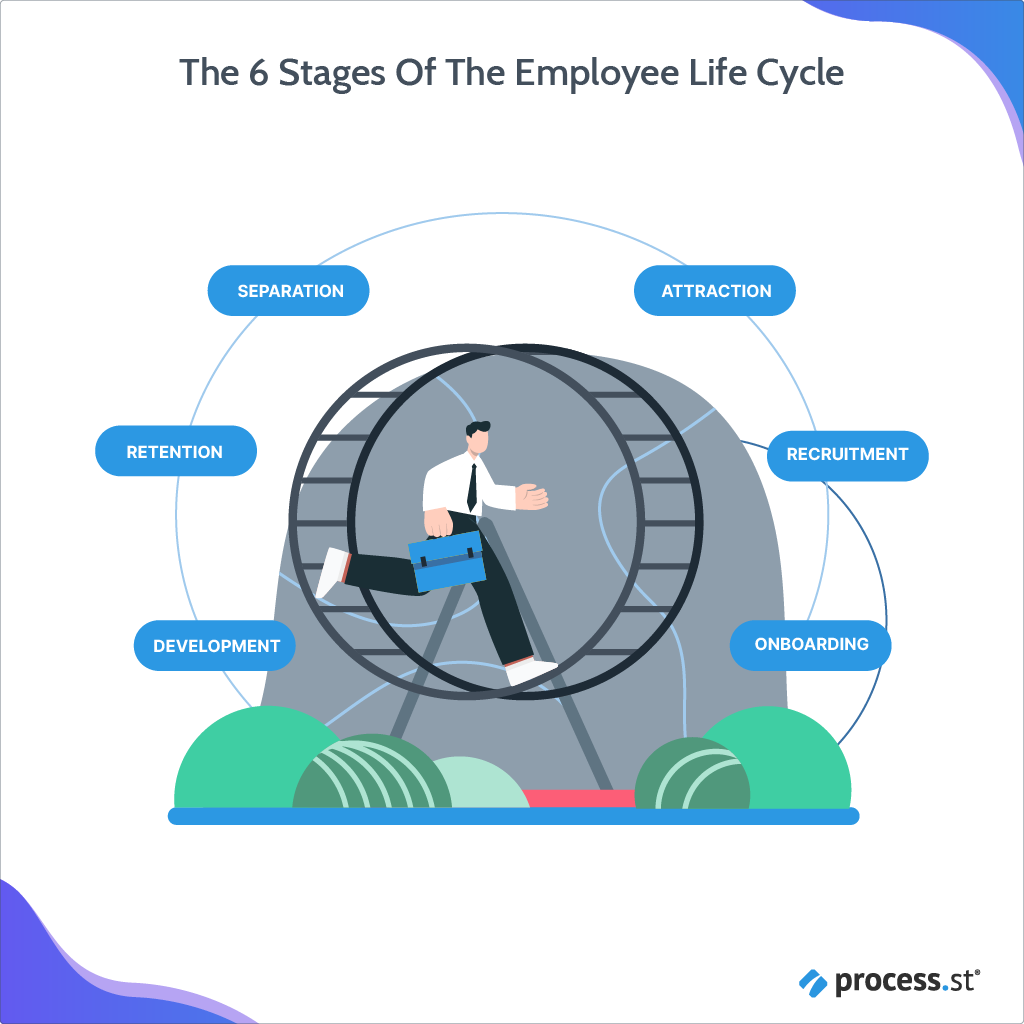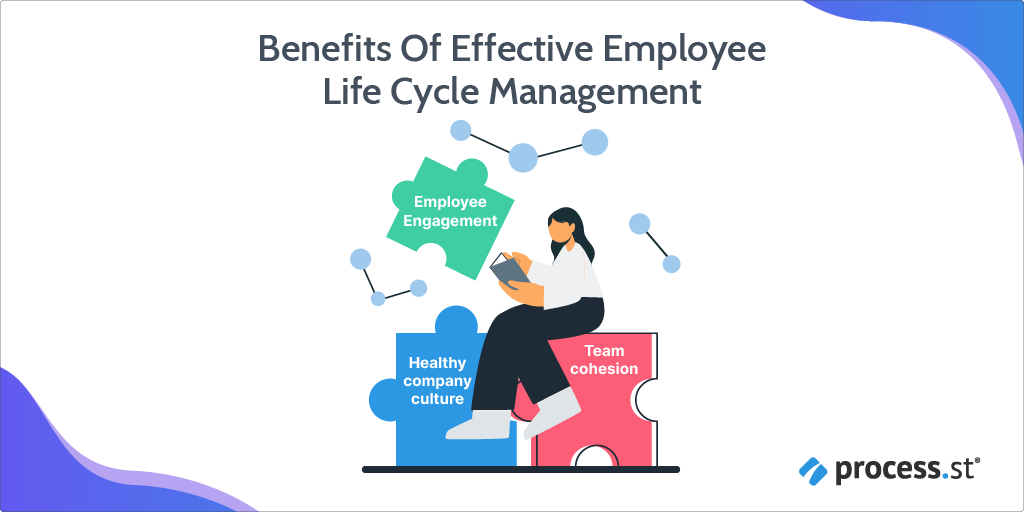
A company is only as good as the employees it hires. We all know this, but let’s take it a step further.
The employee life cycle is the bloodline for any organization. You need to take proper care of your employees to reap success. To do this, you need to understand each stage of the employee life cycle and where your employee stands in it.
When implemented correctly, effective employee life cycle management boosts long-term retention. Your employees are happy, so they remain longer and continue adding value to your business.
That doesn’t mean this management is easy, though. That’s why, in this Process Street article, I’m taking you through each stage with a free template.
- Defining the employee life cycle
- What are the 6 stages of the employee life cycle
- The importance of employee life cycle management
- Life cycle management: Optimize the employee experience
Let’s dive right into it!
Defining the employee life cycle
An employee’s life cycle is a method of measuring their engagement.
By creating a visual map of employee engagement, it breaks down an employee’s entire experience within your organization:
- Attraction
- Recruitment
- Onboarding
- Retention
- Development
- Separation
What are the 6 stages of the employee life cycle?

1. Attraction: Make a good impression
Your employee’s journey with your company begins when they first hear about you – not when you start the recruitment process.
Top talent won’t join a business that can’t represent itself well. 55% of job seekers won’t apply to a company if they’ve read negative reviews about it, which is why the company brand shouldn’t be overlooked.
So, how can you make your company attractive to top talent?
- Offer incentives;
- Make your workplace inclusive and diverse;
- Market your company.
A job description can help you attract this top talent. Here’s a job description template to help make the process easier:
2. Recruitment: Hire top talent
You’re not only evaluating and selecting candidates during the recruitment phase. You’re also providing these job seekers with a close look into your organization, helping them decide if it’s a good fit.
Hiring employees who align with your company culture will positively impact the entirety of their employee life cycle.
You want to prioritize diversity, as diverse businesses have better employee performance and a higher bottom line. Following procedures to avoid any bias while conducting interviews can help you achieve more diversity in the workplace.
One way to do this is to look at the avenues you take to reach these job seekers. It’s important to target the right channels for the candidates you want to attract.
What’s important when using any channel is to be aware of the language used in your recruitment efforts. Is it overtly gendered? Does it discourage those with disabilities from applying? Does it present your company as a genuinely diverse, inclusive, and accessible environment?
Above everything, you want to bring the right people into your organization. To do this, you need a thorough recruiting process. Having a recruiting template is always best, as it helps streamline the process and offers consistency. Here’s one to help you get started:
3. Onboarding: Introduce the newbies
Once you’ve hired a good match for your team, you want to onboard them well. If not, you can expect them to leave within 6 months – if they even last that long. There’s a 16.45% chance your new hire will leave after the first week.
How can you prevent this? A good onboarding experience!
An effective onboarding experience is structured with everything your new hire would need to turn into an acclimated and high-performing team member. From handling those pesky administrative tasks to introducing them to your company culture and various departments, there’s a lot involved in the onboarding process.
Although onboarding can be seen as an introduction to a company, it shouldn’t end after the new hire’s first month. Instead, you can leverage this process to follow into the next stages of the employee lifecycle: Retention and development.
By offering a good onboarding experience, you help retain the employee and provide opportunities for career growth and development.
Here’s how you can make the most of the onboarding process:
- Make the process continuous;
- Define the expectations of the employee’s role;
- Introduce the new hire to departments and colleagues they will be collaborating with;
- Offer training to help integrate them into your company’s unique remote workforce;
- Follow a structured template to ensure consistency and visibility.
Constructing a good onboarding process can be time-consuming. That’s why we’ve got you covered with this employee onboarding template to help you during this phase of the employee life cycle:
4. Retention: Get ‘em to stick around
Onboarding your new hires already puts you in a good position to retain them. But that doesn’t mean your work is over.
Once you’ve wrapped up the onboarding phase and the new employee is working independently in their role and acclimated to the culture, you still need to nurture their loyalty to your organization.
Unlike the recruiting and onboarding phase, less effort is needed. Tactics to boost retention are the same ones HR departments already use to attract and hire the right talent.
Some top tactics for employee retention are:
- Implementing a recognition scheme;
- Acting on employee feedback;
- Making sure you’re sticking to the expectations you made during the attraction, hiring, and onboarding phase.
A great way to ask for employee feedback is through surveys. Here’s an employee satisfaction survey template to help you during the retention phase of the employee life cycle:
5. Development: Just keep growing
Once your employee is settled in their new position, it’s time to mature them within your organization. That means advancing them in their career and creating a larger skill set.
The development part of the employee life cycle is the one that can take your organization to the next level.
Professional development helps keep your employees interested in their position in your company because the work they’re doing is challenging them to grow. To foster this professional growth and development, you want to establish a continuous learning approach.
As you can guess, this starts from the onboarding phase where they are first learning their new role. You should maintain this learning process into the retention and development phase through growth planning and career development schemes.
Here’s a career progression template to guide you through the development phase of the employee life cycle journey:
6. Separation: All good things come to an end
It goes without saying that your company should put measures in place to ensure top talent doesn’t leave until retirement. That doesn’t mean that many employees won’t leave – goodbyes are inevitable.
Not all employees leave because they have had a bad experience with your company. Many times their paths simply grow in a direction, away from the company – and that’s okay. Having them leave on good terms is always best because you’ll still have their loyalty.
For example, our past content manager recently left because he was offered a fantastic opportunity with another company. The team was incredibly happy for him. We all wished him well and HR sent him a farewell present to thank him for everything he did to get the team in the shape it was before he left. A few months passed and his new company is now a customer of Process Street – loyalty.
That doesn’t mean that an employee leaving your company should be a bad experience. You should rather view it as a learning opportunity.
Conducting an exit interview once an employee leaves is great because it offers candid insight into their experience. You can then consider this feedback to ensure you offer a better experience to your next employees – and the cycle continues.
We’ve got an off-boarding and exit interview template that you can use to complete the employee life cycle journey:
The importance of employee life cycle management
As your new hires progress through this life cycle, you can anticipate these needs and adjust accordingly to offer the best possible experience. Many benefits come from providing effective employee life cycle management to your workforce.

Employee engagement
A lack of employee engagement can be caused by few career development opportunities, not feeling seen by employers, and needs not being met. Approximately 36% of employees don’t feel engaged in the workplace, which hinders productivity and can lead to increased churn.
Having effective employee life cycle strategies in place can prevent this lack of engagement.
How? By understanding the different stages of the employee life cycle, you can:
- Set expectations while recruiting for a position;
- Guide the new hire through the onboarding process;
- Integrate them into the company culture;
- Offer career progression opportunities during the development phase;
- Make them feel seen throughout the entire experience.
Healthy company culture
When you have a good understanding of the employee life cycle, you can better implement and maintain your company culture.
That’s because each stage of the employee life cycle has an impact on your workers. Knowing the details of each phase can help you determine how you’d like to impact the employee’s experience and instill your culture.
Prioritizing your company culture will put you in good shape when it comes time to hire new employees. This is because 46% of job seekers believe company culture to be an important factor in accepting a position. So, understanding the employee life cycle can be linked to better hiring.
Team cohesion & retention
HR prioritizing the employee life cycle can help offer insights about these workers to other departments. This can help managers and teams make better decisions when it comes to their employees and the experience they’re giving them.
While the HR department should be directing and guiding the employee life cycle, other departments will play vital roles in nurturing these employees through the various stages.
Not only does this improve collaboration in the organization, but it helps provide more efficient employee life cycle management for optimized results.
The all-in-one model for employee life cycle management
Did I say there were only six templates?
Each of the above templates can be used on its own or in tandem to create your own employee life cycle experience. We’ve gone one step further and also designed an all-in-one employee life cycle model template you can use more or less straight out of the box.
Like all of our templates, it’s fully customizable. You can add or remove tasks, move them around, move fields between tasks, and the whole width and breadth of everything that Process Street has to offer.
So check this out:
Life cycle management: Optimize the employee experience
Understanding the employee life cycle is a brilliant tool to ensure you’re addressing the needs of your employees during each phase of their journey. However, it can be difficult to grasp each stage.
That’s why using a template to assist during these different stages is a good idea. A template is the framework of a process. The process helps offer effective life cycle management.
Process automation helps streamline the process while you ensure a consistent experience for each employee. With proper process documentation and implementation, you can truly optimize your employee life cycle management.
What do you think is the most important phase of the employee life cycle? Let us know in the comments!







 Workflows
Workflows Projects
Projects Data Sets
Data Sets Forms
Forms Pages
Pages Automations
Automations Analytics
Analytics Apps
Apps Integrations
Integrations
 Property management
Property management
 Human resources
Human resources
 Customer management
Customer management
 Information technology
Information technology



Grace Donaldson
Grace is a content writer with a thirst for knowledge and coffee. You'll find her reading in a small café or singing at a rundown jazz bar when she's not overconsuming coffee or compartmentalizing her thoughts into a blog post.